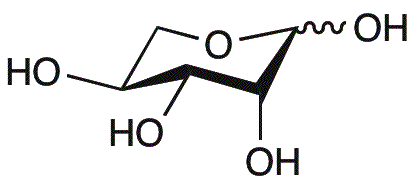L-Lyxose is widely utilized in research focused on:
- Biochemical Research: It serves as a key substrate in the study of carbohydrate metabolism, helping researchers understand sugar-related pathways in living organisms.
- Pharmaceutical Development: L-Lyxose is explored for its potential role in developing new drugs, particularly in targeting metabolic disorders and diabetes management.
- Food Industry: It is used as a low-calorie sweetener, providing a healthier alternative to traditional sugars without compromising taste.
- Cosmetic Formulations: The compound is incorporated into skincare products for its moisturizing properties, enhancing the texture and hydration of creams and lotions.
- Research on Glycobiology: L-Lyxose is significant in the synthesis of oligosaccharides, aiding in the exploration of glycoproteins and their functions in biological systems.
General Information
Properties
Safety and Regulations
Applications
L-Lyxose is widely utilized in research focused on:
- Biochemical Research: It serves as a key substrate in the study of carbohydrate metabolism, helping researchers understand sugar-related pathways in living organisms.
- Pharmaceutical Development: L-Lyxose is explored for its potential role in developing new drugs, particularly in targeting metabolic disorders and diabetes management.
- Food Industry: It is used as a low-calorie sweetener, providing a healthier alternative to traditional sugars without compromising taste.
- Cosmetic Formulations: The compound is incorporated into skincare products for its moisturizing properties, enhancing the texture and hydration of creams and lotions.
- Research on Glycobiology: L-Lyxose is significant in the synthesis of oligosaccharides, aiding in the exploration of glycoproteins and their functions in biological systems.
Documents
Safety Data Sheets (SDS)
The SDS provides comprehensive safety information on handling, storage, and disposal of the product.
Product Specification (PS)
The PS provides a comprehensive breakdown of the product’s properties, including chemical composition, physical state, purity, and storage requirements. It also details acceptable quality ranges and the product's intended applications.
Certificates of Analysis (COA)
Search for Certificates of Analysis (COA) by entering the products Lot Number. Lot and Batch Numbers can be found on a product’s label following the words ‘Lot’ or ‘Batch’.
*Catalog Number
*Lot Number
Certificates Of Origin (COO)
This COO confirms the country where the product was manufactured, and also details the materials and components used in it and whether it is derived from natural, synthetic, or other specific sources. This certificate may be required for customs, trade, and regulatory compliance.
*Catalog Number
*Lot Number
Safety Data Sheets (SDS)
The SDS provides comprehensive safety information on handling, storage, and disposal of the product.
DownloadProduct Specification (PS)
The PS provides a comprehensive breakdown of the product’s properties, including chemical composition, physical state, purity, and storage requirements. It also details acceptable quality ranges and the product's intended applications.
DownloadCertificates of Analysis (COA)
Search for Certificates of Analysis (COA) by entering the products Lot Number. Lot and Batch Numbers can be found on a product’s label following the words ‘Lot’ or ‘Batch’.
*Catalog Number
*Lot Number
Certificates Of Origin (COO)
This COO confirms the country where the product was manufactured, and also details the materials and components used in it and whether it is derived from natural, synthetic, or other specific sources. This certificate may be required for customs, trade, and regulatory compliance.

